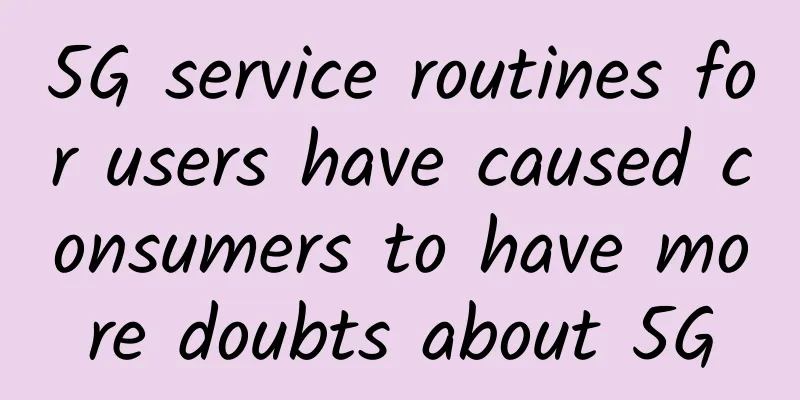The era of "small profits but quick turnover" for mobile data traffic is over

|
For four consecutive years, the government work report has set annual "small goals" for "speeding up and reducing fees". However, in stark contrast to previous years, this year's government work report only proposed "reducing the average broadband and dedicated line charges by 15%", and no longer set a target for reducing mobile network traffic charges. In the past, for example in the government work reports of 2018 and 2019, it was proposed successively that "mobile network traffic charges will be reduced by at least 30% within the year" and "the average mobile network traffic charges will be reduced by more than 20%." Why is there no mention of reducing mobile network data charges? What is the reason behind this? One of the reasons is that since 2015, after five consecutive years of vigorously promoting the "speeding up and reducing fees" work, the level of mobile network traffic charges in my country has dropped significantly, and the contradiction of high charges has been greatly alleviated. In the first quarter of 2017, the average mobile data charges in my country exceeded 35 yuan/GB, which dropped to 5 yuan/GB in the fourth quarter of 2019, and further dropped to 4.4 yuan/GB in the first quarter of 2020. At present, my country's data charges are much lower than those in the United States, Japan, South Korea and other countries, and there is little room for decline. The second reason is that the "small profits but quick turnover" effect brought about by the reduction in traffic charges has been greatly weakened compared with the past, and the growth of traffic usage has shown a significant slowdown, resulting in weak revenue growth. At present, traffic revenue is still the mainstay of revenue for telecom operators. Before emerging businesses truly take on the "main responsibility", if we blindly demand lower traffic charges, once this "pillar" falls or is on the verge of crumbling, it will not only be detrimental to the telecom operator industry as a whole, but more importantly, it will have an adverse impact on accelerating the development of 5G and the progress of "new infrastructure". After all, operators play an extremely important role in the fields of 5G and "new infrastructure". In the past few years, the consumption stimulation effect brought about by the reduction of traffic charges has been very obvious, releasing the potential of residents' information consumption. This is not an empty statement, as can be proved by a series of detailed data. From 2015 to 2018, my country's mobile Internet access traffic (of which mobile Internet traffic accounts for the vast majority) consumption level has maintained an annual growth rate of more than 100%, which is rare in the world. In particular, 2017 and 2018 were the peak years, with the year-on-year growth rate of mobile Internet access traffic exceeding 150% each year. For individual users, it is obvious that they dare to use more traffic and use more and more traffic every month. In 2015, the average monthly mobile Internet access traffic (DOU) in my country reached 389.3MB/household/month, which means that each mobile phone user used less than 400MB of traffic per month. By December 2019, this figure had reached 8.59GB/household/month, a full 23 times increase. In the past few years, although traffic charges have been reduced, the stimulating effect brought about by the price reduction has caused people's traffic consumption level to increase very rapidly, which has led to a rapid growth in the data traffic revenue of telecom operators and has gradually become a pillar source of income for telecom operators. my country's average mobile data traffic charges and users' average monthly mobile data usage Source: CAICT Take 2018 as an example. That year, China Mobile's mobile Internet traffic soared 182% year-on-year, driving a 9.8% increase in mobile Internet traffic revenue. Mobile Internet traffic revenue reached 369.4 billion yuan, accounting for 55.1% of its communication service revenue and 50% of its operating income, becoming its undisputed largest source of income. For the other two operators, mobile Internet traffic revenue has also become the main driving force for their respective revenue growth. In 2018, China Telecom's mobile Internet traffic increased significantly by 291%, and mobile traffic revenue increased by 22.4% year-on-year to 111.2 billion yuan, accounting for nearly 30% of the overall operating revenue. This year, China Unicom's mobile Internet traffic also surged 1.8 times, and mobile Internet revenue increased by 13.7% year-on-year to 104.8 billion yuan, accounting for 36% of the overall operating revenue. During this period, although the "volume-revenue gap" between traffic business growth and traffic revenue growth has been widening to an unprecedented level, the "small profits but quick turnover" effect has stimulated the rapid growth of operators' traffic revenue and made a huge contribution to the growth of business revenue, so the contradiction of the "volume-revenue gap" has not attracted much attention. However, as time goes by, the effect of "small profits but quick turnover" is weakening. Judging from the situation in 2019 and the first four months of this year, the growth rate of user traffic consumption levels has slowed down significantly, showing a weak trend. 'According to data released by the Ministry of Industry and Information Technology, the growth rate of my country's mobile Internet access traffic in 2019 has dropped from more than 100% per year to 71.6%, a 116.7 percentage point decrease from the previous year. Specifically, the three telecom operators are facing the same situation. Compared with the previous year, the growth rate of mobile Internet traffic has declined significantly. China Mobile's growth rate has dropped from 182.1% in 2018 to 90.3% in 2019, China Telecom has dropped from 291% to 73.2%, and China Unicom has dropped from 180% to 46%. In other words, although mobile Internet traffic is still growing, it has changed from the "big strides" of the past to the "small steps" of today. As the growth of traffic consumption levels slows down, if traffic charges are required to continue to decline to a certain extent, mobile traffic revenue may enter a negative growth channel, which will inevitably slow down the growth of operators' overall business and make operators face a more severe situation. For the domestic operator industry, which has previously suffered from the situation of too fast release of traffic dividends, the current "speed increase and fee reduction" does not have a "hard rule" for reducing traffic charges, allowing telecom operators to "take a break and breathe" so as to better promote 5G and "new infrastructure". At the same time, it is hoped that 5G applications can mature as soon as possible, not only industry applications, but also personal applications, to open up new horizons for the development of operators. |
<<: IDC: Global Enterprise WLAN Market Shows Moderate Decline in First Quarter of 2020
>>: CCS Insight: 5G connections to jump to 3.2 billion by the end of 2025
Recommend
Cisco ushers in a new era of networking
The recent WannaCry ransomware cyberattack target...
Why is Telnet insecure? Let's take a look at usernames and passwords
Once upon a time, Telnet was my favorite remote l...
UFOVPS is 50% off, top up 200 yuan and get 20 yuan, Japan CN2 GIA/Hong Kong CN2 GIA/US high-defense VPS monthly payment starts from 19 yuan
UFOVPS has released the biggest discount this yea...
Maxthon Hosting: Hong Kong VPS monthly payment starting from 40 yuan, mobile CMI large bandwidth, optional CN2 line
Friends who use mobile networks can pay attention...
HostNamaste: 128G-8TB large hard disk VPS monthly payment starts at $4.99, 2G memory special VPS annual payment starts at $36, Los Angeles & Dallas data centers
HostNamaste recently promoted special annual VPS ...
[Black Friday] SaltyfishTech: 499 yuan/year-4 cores/4GB/50G SSD/1TB@150Mbps/Germany 9929 line
SaltyfishTech also released a special Black Frida...
5G Era Series: Battle of Big Companies
[[395527]] Nearly two years have passed since the...
How does network automation simplify network operations?
In today's rapidly evolving digital environme...
The three major operators are deploying the next generation of the Internet of Things and have determined three specific directions
In 2017, the Internet of Things industry ushered ...
[Black Friday] spinservers: 10Gbps San Jose/Dallas servers starting at $89/month, 50% off on all hybrid servers, $200 off on high-end servers
The Black Friday promotion of spinservers continu...
The 5G standard is here, when will the licenses and mobile phones arrive?
Just a few days ago, the plenary session of the i...
Five IoT trends that we need to pay attention to in 2018!
The Internet of Things has become a globally reco...
The Smart Network: Cisco's most disruptive innovation in a decade
A little over a year ago, my colleague David McGr...
my country successfully developed a 62-bit quantum computing prototype "Zu Chongzhi"
In the field of quantum computers, my country'...
Biyouxue: Solve growing pains with software development cloud
Education is an eternal research topic, and its i...









